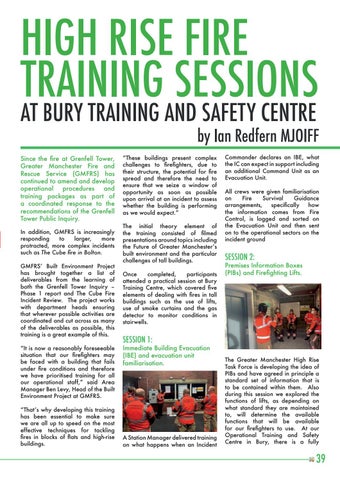HIGH RISE FIRE TRAINING SESSIONS AT BURY TRAINING AND SAFETY CENTRE
by Ian Redfern MJOIFF
Since the fire at Grenfell Tower, Greater Manchester Fire and Rescue Service (GMFRS) has continued to amend and develop operational procedures and training packages as part of a coordinated response to the recommendations of the Grenfell Tower Public Inquiry. In addition, GMFRS is increasingly responding to larger, more protracted, more complex incidents such as The Cube fire in Bolton. GMFRS’ Built Environment Project has brought together a list of deliverables from the learning of both the Grenfell Tower Inquiry – Phase 1 report and The Cube Fire Incident Review. The project works with department heads ensuring that wherever possible activities are coordinated and cut across as many of the deliverables as possible, this training is a great example of this. “It is now a reasonably foreseeable situation that our firefighters may be faced with a building that fails under fire conditions and therefore we have prioritised training for all our operational staff,” said Area Manager Ben Levy, Head of the Built Environment Project at GMFRS. “That’s why developing this training has been essential to make sure we are all up to speed on the most effective techniques for tackling fires in blocks of flats and high-rise buildings.
“These buildings present complex challenges to firefighters, due to their structure, the potential for fire spread and therefore the need to ensure that we seize a window of opportunity as soon as possible upon arrival at an incident to assess whether the building is performing as we would expect.” The initial theory element of the training consisted of filmed presentations around topics including the Future of Greater Manchester’s built environment and the particular challenges of tall buildings. Once completed, participants attended a practical session at Bury Training Centre, which covered five elements of dealing with fires in tall buildings such as the use of lifts, use of smoke curtains and the gas detector to monitor conditions in stairwells.
Commander declares an IBE, what the IC can expect in support including an additional Command Unit as an Evacuation Unit. All crews were given familiarisation on Fire Survival Guidance arrangements, specifically how the information comes from Fire Control, is logged and sorted on the Evacuation Unit and then sent on to the operational sectors on the incident ground
SESSION 2:
Premises Information Boxes (PIBs) and Firefighting Lifts.
SESSION 1:
Immediate Building Evacuation (IBE) and evacuation unit familiarisation.
A Station Manager delivered training on what happens when an Incident
The Greater Manchester High Rise Task Force is developing the idea of PIBs and have agreed in principle a standard set of information that is to be contained within them. Also during this session we explored the functions of lifts, as depending on what standard they are maintained to, will determine the available functions that will be available for our firefighters to use. At our Operational Training and Safety Centre in Bury, there is a fully
39












